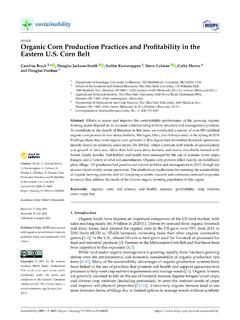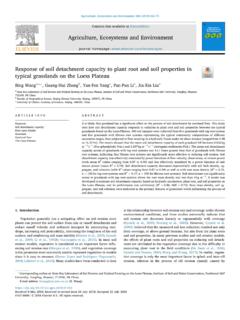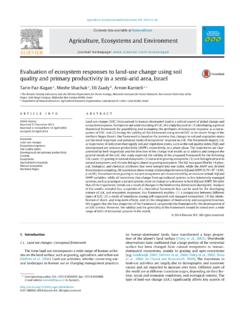Transcription of Agriculture, Ecosystems and Environment
1 ReviewGoing where no grains have gone before: From early to mid-successionTimothy E. Crewsa,*, Jennifer Bleshb, Steven W. Culmanc, Richard C. Hayesd,Erik Steen Jensene, Michelle C. Mackf, Mark B. Peoplesg, Meagan E. SchipanskihaThe Land Institute, 2440 E. Water Well Rd., Salina, KS 67401, United StatesbSchool of Natural Resources and Environment , University of Michigan, 440 Church St., Ann Arbor, MI 48109, United StatescSchool of Environment and Natural Resources, The Ohio State University, 130 Williams Hall, 1680 Madison Ave, Wooster, OH 44691, United StatesdNSW Department of Primary Industries, Wagga Wagga Agricultural Institute, PMB, Wagga Wagga, NSW 2650, AustraliaeDepartment of Biosystems and Technology, Swedish University of Agricultural Sciences, Box 103, SE-230 53 Alnarp, SwedenfCenter for Ecosystem Science and Society, Northern Arizona University, Box 5620, Flagstaff, AZ 86011, United StatesgCSIRO agriculture , Box 1600, Canberra, ACT 2601, AustraliahSoil and Crop Sciences, Colorado State University, 307 University Ave.
2 , Fort Collins, CO 80523, United StatesA R T I C L E I N F OArticle history:Received 12 November 2015 Received in revised form 6 March 2016 Accepted 8 March 2016 Available online 15 March 2016 Keywords:AgroecosystemDisturbanceIntercr opLegumeNitrogenPerennialSoil organic matterA B S T R A C TAnnual-based arable agroecosystems experience among the greatest frequency, extent and magnitude ofdisturbance regimes of all terrestrial Ecosystems . In order to control non-crop vegetation, farmersimplement tillage practices and/or utilize herbicides. These practices effectively shift the farmedecosystems to early stages of secondary succession where they remain as long as annual crops are s long-standing dependence on a disturbance-based food and fiber producing ecosystem hasresulted in degraded soil structure, unsustainable levels of soil erosion, losses of soil organic matter, lownutrient and water retention, severe weed challenges, and a less-diverse or functional soil no-till cropping systems have reduced some hazards like soil erosion, they remain compromisedwith respect to ecosystem functions like water and nutrient uptake, and carbon sequestration comparedto many later successional Ecosystems .
3 Recent advances in the development of perennial grain cropspecies invite consideration of the ecological implications of farming grains further down thesuccessional gradient than ever before possible. In this review, we specifically explore how the nitrogen(N) economy of a mid-successional agroecosystem might differ from early-successional annual grainecosystems as well as native mid-successional grassland Ecosystems . We present a conceptual modelthat compares changes in soil organic matter, net ecosystem productivity, N availability, and N retentionthrough ecosystem succession. Research from the agronomic and ecological literatures suggest that mid-successional grain agriculture should feature several ecological functions that could greatly improvesynchrony between soil N supply and crop demands; these include larger active soil organic matter pools,a more trophically complex and stable soil microbiome that facilitates higher turnover rates of availableN, greater N retention due to greater assimilation and seasonal translocation by deeply rooted perennialspecies as well as greater microbial immobilization.
4 Compared to native mid-successional grasslandsthat cycle the majority of N required to maintain productivity within the ecosystem, a mid-successionalagriculture would require greater external N inputs to balance N exports in food. Synthetic N fertilizercould make up this deficit, but in the interest of maximizing ecological intensification in order tominimize inputs and associated environmental consequences, we explore making up the N deficit withbiological N2fixation. The dominant approach to addressing problems in agriculture is to target specificshortcomings such as nutrient retention or weed invasion. Moving agriculture down the successionalgradient promises to change the nature of the ecosystem itself, shifting attention from symptom to cause,such that ecological intensification and provision of a broader suite of ecosystem services happen not inspite of, but as a consequence of agriculture . 2016 Elsevier All rights reserved.* Corresponding addresses: ( Crews), (J.)
5 Blesh), ( Culman), ( ( Jensen), ( Mack), ( Peoples), ( Schipanski). 2016 Elsevier All rights , Ecosystems and Environment 223 (2016) 223 238 Contents lists available at ScienceDirectAgriculture, Ecosystems and Environmentjournal homepage: /ageeContents1. Introduction .. Why nitrogen? .. Why legumes? .. 2252. Succession as an agroecosystem concept .. Succession, human roles, and human failures .. A conceptual model .. Changes in soil organic matter (SOM) with ecosystem succession .. Net ecosystem production (NEP) and net ecosystem carbon balance (NECB) through ecosystem succession .. Changes in plant available N with ecosystem succession .. Changes in N losses via gaseous and leaching pathways .. 2293. Mechanisms governing N availability across successional stages .. Changes in soil communities that influence N cycling during succession .. Nitrogen translocation in perennials .. 2314. Nitrogen limitation under conditions of positive NEP and the role of legumes.
6 Legume N2fixation in annual versus perennial systems .. Factors that regulate legume productivity .. Nutrients other than N .. Soil mineral N .. N-transfer from legume to crop .. 2345. Conclusion .. 235 Acknowledgements .. 236 References .. 2361. IntroductionIn contrast to native Ecosystems , agricultural Ecosystems tendto include far fewer species of plants and animals. Agroecologistshave recognized this distinction for some time, and the topic ofhow much and what type of planned agrobiodiversity wouldimprove the functionality and ecological intensification ofagriculture continues to receive a great deal of attention(Bommarco et al., 2013; Lin, 2011; Swift et al., 2004). A secondbroad distinction between native and agroecosystems one thathas received far less attention from agroecologists is that ofsuccession. Following disturbance, native Ecosystems regainfunctionality through successional changes that strengthen arange of internal, regulating feedbacks.
7 In contrast, due torecurring tillage events or herbicide applications, annual cropecosystems remain arrested in a disturbed, less regulated state ofearly secondary succession (Smith, 2014). As a result, degradingprocesses of soil erosion (Montgomery, 2007), nutrient and waterleaching (MEA, 2005; Vitousek and Reiners, 1975), soil organicmatter decline (Davidson and Ackerman, 1993), and extensiveweed establishment (Liebman and Mohler, 2001) compromise theagroecosystems themselves as well as Ecosystems situated downwind, hill or stream. Under these conditions, the opportunities forachieving production goals through ecological intensification arelimited (Tittonell and Giller, 2013).In attempts to rein in the consequences of chronic perturbation,agronomists and ecologists have developed cropping systems thatattempt to maximize continuous plant cover on the landscapethrough cover crops or integration of perennial buffer strips orforage crops (Blesh and Drinkwater, 2013; Liebman et al.)
8 , 2013).These systems have demonstrated improvements in nutrientretention, carbon (C) accumulation and weed suppression throughreduction of soil disturbance and vegetation replacement, andthere is good reason to incentivize their adoption. However, theseefforts fall short of addressing the root of agriculture s successionalstagnation. Critical to the development of numerous ecosystemfunctions in native ecosystem succession indeed critical tosuccession itself is the transition from community dominanceby annual to perennial plant species (Connell and Slatyer, 1977).The prospect of establishing a parallel successional trajectory inagriculture could be transformative (Fig. 1). To this end, breedingprograms in multiple countries are now developing hybrid plantpopulations or new domestications of perennial grain crops, withpromising early results for perennial wheat (Triticum spp. Thinopyrum spp.), rice (Oryza sativa O. longistaminata), sorghum(Sorghum bicolor S.
9 Halepense), pigeon pea (Cajanus cajan) andoilseeds (Batello et al., 2013; Kantar et al., 2016).A perennial crop agriculture that exists in a later stage ofsuccession is predicted to change in some cases dramatically with respect to multiple agroecosystem processes and attributesincluding soil and nutrient retention, C sequestration, waterinfiltration and uptake efficiencies, weed suppression, phosphorus(P) and N availability and soil structure (Glover et al., 2007;Robertson et al., 2011). All of these merit consideration, but herewe focus on how the N economy of a mid-successional agro-ecosystem might change across successional seres, highlightingdifferences between perennial and annual agroecosystems, as wellas unique positive and negative attributes of a mid-successionalecosystem that have yet to be considered in an agricultural we focus primarily on N, we also examine ecosystemattributes and feedbacks that govern the N economy such aschanges in soil C balance, microbiome, and dominant forms of Why nitrogen?
10 The importance of N in sustaining food production, and theserious challenges faced by farmers to manage N resourcesefficiently make it a salient topic in the context of disturbanceand succession. Nitrogen is the nutrient that most commonlylimits the productivity of agroecosystems and, either alone or withP, native terrestrial Ecosystems (Robertson and Vitousek, 2009;Vitousek and Howarth, 1991). Yet on average, only 30 50% of Napplied is recovered in a fertilized grain crop, and beyond that, <7%of the applied N is recovered in up to six subsequent crops (Gardnerand Drinkwater, 2009; Ladha et al., 2005). Low N fertilizer uptakeefficiencies, caused by the application of high concentrations of themost soluble N forms to fields at times when annual crop roots areeither underdeveloped or not present at all, result in substantial Nlosses to the Environment (Robertson et al., 2011). Nitrate-N and toa lesser extent dissolved organic N is lost to surface or groundwatervia hydrologic pathways, causing local contamination of224 Crews et al.










